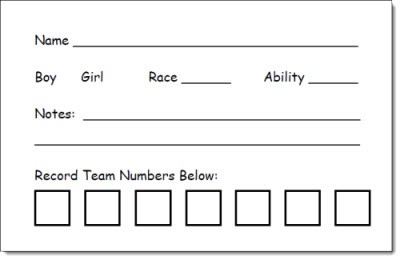Forming effective teams is a important when implementing cooperative learning strategies, but it’s not always easy to figure out the best way to form teams of students who will work well together. Here are some tips, strategies, and free resources to help you get started!

What’s the Most Effective Team Size?
Research has shown that a team of four students is the most effective size for several reasons. A four-person team allows for many different kinds of interactions. The group can work as a team, or it can be broken down into two sets of partners. Each team should be as heterogeneous as possible so that kids can learn to work with all different kinds of people.
When Should You Form Teams?
Teachers often wonder if they should start out with their students in rows and move them into teams after the first week, or if they should seat them in teams from the first day of school.
Personally, I like to start off on Day 1 with the kids in random teams (since I don’t know enough about them to form heterogeneous teams). I want them to know that this is the usual way we do things, and that cooperative learning is not just fun and games. I teach them from the very beginning how to have self-control when sitting in a team, and how to deal with problems and distractions. Each day for the first 3 or 4 days I randomly assign them to different teams so they can get to know all of their classmates quickly.
Important Factors to Consider
- If possible, each team should consist of one high-performing student, two average students, and one low-performing student.
- Teams should generally include both boys and girls.
- Each team should reflect the ethnic diversity of your classroom.
- Cooperative Learning teams generally stay together for about six weeks in upper elementary classrooms. Older students may be fine in the same team for an entire grading period.
- Cooperative Learning teams generally stay together for about six weeks in upper elementary classrooms. Older students may be fine in the same team for an entire grading period.
- After forming your teams, provide opportunities for them to get to know each other. These icebreaker activities are called “team builders” and they are essential.
Two Methods of Forming Effective Teams
Option #1: Quick and Easy Index Card Method
- Write each student’s name on an index card.
- Deal the cards into 4 equal piles according to student ability (High, Medium High, Medium Low, and Low)
- Choose one card from each pile. Be sure to include a mix of students (according to gender, race, and personality). Set this stack aside as Team 1.
- Form the remaining teams in the same way. Assign a team number to each stack of cards.
- On a separate sheet of paper, record the name of each team and its team members. That way you’ll have something to refer to the next time you form teams. You don’t want kids to end up on the same teams over and over.
Option #2: Team Formation Cards Method

This method isn’t much harder than the index card method, but it has more steps. You will also need a set of the Team Formation Cards shown on the right. Here’s a sample card to help you follow along with the explanation.
Step by Step Directions:
- Print enough Team Formation cards so that you have one card for each student in the class. Never show these cards to your students!
- Write each students’ name on a card, circle “boy” or “girl,” and fill out the section on race.
- For ability, decided if the student is High (H), Medium High (MH), Medium Low (ML), or Low(L). The numbers of students for each category need to be roughly the same. This judgement is very subjective and can include areas such as leadership ability, willingness to work hard and complete homework, organization skills, ability to follow directions, and so on.
- In the Notes section, write down any miscellaneous information such as learning disabilities, personalities, special needs, etc.
- After you fill out the cards, spread them out in rows on a table. For this example we will assume you have 28 students in your class, which means you will have 7 students in each category.
- Start by placing your 7 highest students in one COLUMN. Your Highs can be thought of as the leaders in your class; these are the kids you can count on to lead the group in a positive direction. Next, place your 7 Medium High students in a column beside the Highs. Continue with a column for the Medium Lows and the Lows.
- When you finish, you will have an array of cards that is 4 columns wide and 7 rows high. As you look over the array of cards, picture each ROW as a team. Look across each row and decide if you need to switch some cards to make the team more balanced. Do you have two boys and two girls? Do you have one High, one Medium High, one Medium Low, and one Low student? Does each team accurately represent the ethnic composition of your class? Will the students get along with each other? Look at all the teams and continue switching cards in each column until you have teams that are as heterogeneous as possible.
- It’s important to have a way of keeping track of who has been on which team. The Team Number boxes will help you remember who has been on each team throughout the year. After forming teams, record each student’s team number in the box on the bottom of his or her card. To assign team numbers, start with the top row and call it Team 1. Write a 1 in the first box on every team member’s card. The next team becomes Team 2, so write the number 2 in the first box on their cards. Continue with all 7 teams. After six weeks have passed and you form new teams, you will be able to see at a glance who was on each team. That way you can make sure that most students are placed with new team members each time.
Frequently Asked Questions
- What if the number of students in my class isn’t divisible by four?You can have teams of three or teams of five also, but any more than five students seems to be a problem. I prefer teams of three if I have extras. This is because I notice that in a team of five, one student seems to be left out. Other teachers prefer to have a few teams of five because they have students who are frequently absent. They place these students on five-member teams so that any time that student is absent, the team has four members. However, sometimes I wonder if these students might be less likely to be absent if they perceived themselves to be important members of small teams. If they are seated at the end of a five-person team, they may feel that they are not needed.
- My school operates on a Nine Week schedule. Is it okay to keep teams together for nine weeks instead of six?If students stay together all day, six weeks is still the optimal number of weeks to keep teams together. I have learned this through my own experience. After this amount of time, I spend too much time dealing with social skills. If they are looking at each other ALL DAY every day, maybe they don’t need to be together more than six weeks! However, if you teach in a middle school or high school setting and you have the students for just one period a day, you can keep them together for nine weeks without any problem. Most of the middle school teachers I know do exactly that.
- What about that student who can’t get along with anyone?I place all my students on a team, but if I have someone who is extremely rude and hard to get along with, I provide another seat in the class also. I let the class know that working on a team is fun, but it comes with certain responsibilities. You have to respect the members on your team and treat them as you would like to be treated. If someone can’t seem to do that, I remove them from the team for that day and give them an alternate assignment that’s not nearly so fun. In fact, I make sure the assignment is very challenging and involves lots of paperwork. If they ask for help, I say that if they were on a team they could get help. I let them know that if they complete the assignment and come in the next day with a better attitude, they may rejoin their team. I have had very difficult students who would start every day with their team and by lunch time they were on their own. Gradually, though, they were able learn how to treat the other students with respect and stay in the team all the time. Just be clear about your expectations for behavior.
- What if my school tracks students into ability groups and I have all low-ability students? Even within a group of students who are similar in ability, some students stand out above the others as leaders. Spread those students out among the teams, and use the other factors such as race, gender, and personality to form heterogeneous groups. But above all, please use cooperative learning with these kids! They need it more than any other group!
Final Note: The tips and strategies in this post deal with deciding who should be in each team. For more information about how to physically arrange your desks to accommodate a team of four students, read my Cooperative Learning Seating Options post.








